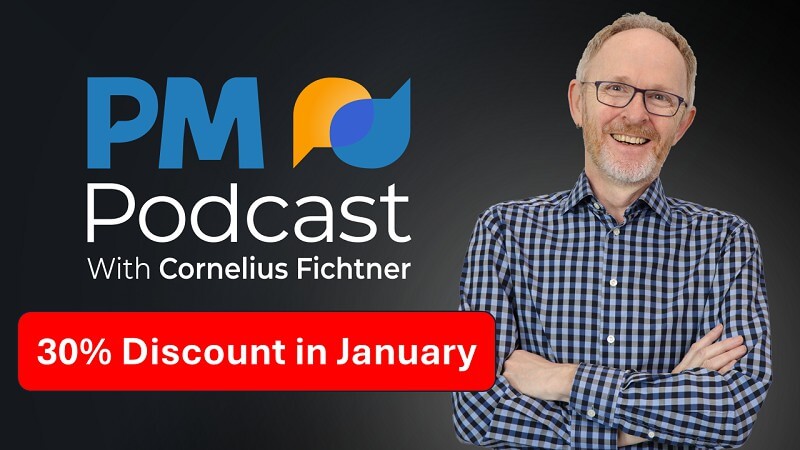Episode 199: How to Implement Project Portfolio Management
This episode is reserved for subscribers of the Premium Podcast. Learn how to subscribe to the Premium Podcast to access this interview and transcript...
This episode is sponsored by The PDU Podcast:
 In our first interview with Jamal Moustafaev, PMP (www.thinktankconsulting.ca) we looked at what portfolio management is and what benefits it will bring to a company once they have it implemented. But how do you implement it? Where do you start with portfolio management and what strategic approaches should you apply?
In our first interview with Jamal Moustafaev, PMP (www.thinktankconsulting.ca) we looked at what portfolio management is and what benefits it will bring to a company once they have it implemented. But how do you implement it? Where do you start with portfolio management and what strategic approaches should you apply?
These are lots of good questions and Jamal has lots of good answers coming up.
As always, when we have an author on the program to discuss his or her book, we are giving away two copies. One copy automatically goes to one lucky premium subscriber and the other one is up for grabs. Please stop by at facebook.com/pmpodcast and look for the book giveaway notice.
Episode Transcript
Below are the first few pages of the transcript. The complete transcript is available to Premium subscribers only.
Podcast Introduction
Cornelius Fichtner: Hello and welcome to Episode #199. This is The Project Management Podcast™ at www.project-management-podcast.com and I am Cornelius Fichtner. This is a premium episode reserved for our premium members which means that because you’re listening to it, you are a premium member and you have automatically been entered into our book giveaway.
Today’s guest is Jamal Moustafaev who wrote a “A Practical Guide to Project Selection, Scoping, Estimation and Management.” And one copy will be raffled off among all of you premium subscribers.
In our first interview with Jamal, we looked at what portfolio management is and what benefits it will bring to a company once they have implemented it. But how do you implement it? Where do you start with portfolio management and what strategic and tactical approaches should you apply? These are all lots of good questions and Jamal has lots of good answers coming up.
And now, for the 199th time, enjoy the interview.
Podcast Interview
Female voice: The Project Management Podcast’s feature Interview: Today with Jamal Moustafaev, author, speaker and portfolio management expert.
Cornelius Fichtner: Hello Jamal, welcome back to the program!
Jamal Moustafaev: Thank you, Cornelius! Thank you for having me, very happy to be here again.
Cornelius Fichtner: Alright! So we’re still inside your book: “Delivering Exceptional Project Results – A Practical Guide to Project Selection, Scoping, Estimation and Management.” But we are wanting to take the next step because we now want to talk about how do we go about where we want to implement project portfolio management in a company, in our company, in an organization.
But let’s start once again in the other corner here and see whether or not portfolio management brings any value. Is there any scientific data out there showing the impact of portfolio management?
Jamal Moustafaev: Actually, yeah. Very frequently with my clients, I have to share that information with them. There is quite a lot of data but for the purposes of this interview, I prepared kind of the 4 key highlights.
There was a study done recently where they point basically to 205 differences mainly in states. The mean size of the business is 6.4 billion dollars in sales so not small companies, big companies. The way they did, they took these 205 businesses and they divided them in 3 groups: Best performers, medium performers and poor performers. That was based solely on their staff performance so they would trade it on I guess stock exchanges and they ranked them in these three buckets, so to speak, and then they compared what are the project portfolio management practices in the winners bucket versus the not-winners bucket. Let’s put it this way.
Here is what they discovered that when it comes to having a formal and systematic portfolio management in place, the percentage was close to 60% of winners had it and only 4% of poor performance had it. So that’s a ratio roughly of 15 to 1.
If you look at the category “Resource breakdown reflects business strategy,” among the best performers, the number was 66% roughly speaking; among the worst performers, 8%. So that’s a ratio of more than 8 to 1.
If you look at the category of “Portfolio contains high value projects,” the ratio was, I can’t even give you the ratio because it’s 40% to 0%.
Good job company is doing good job over ranking prioritizing projects, 40% versus 12%. So that’s would be what, three-and-a-half to one? So just these 4 points, I think they demonstrate that there’s a very, very strong correlation between having portfolio management and having good staff performance.
Cornelius Fichtner: Perfect, okay! You have just convinced me. We decided in my company, we are going to implement project portfolio management. So where should we as a company start with project portfolio management?
Jamal Moustafaev: Again, number one thing very frequently a method by many companies that try to do that, you have to have a commitment to be starting a systematic, formal and rigorous PPM process. And guess what? That commitment should be coming from the very top of the company. If C level people at the company, the CEO, the CFO, CTO, CIO, et cetera, et cetera. If you don’t have their buy-in, that would be waste of time.
You have to conduct portfolio management training and workshop possibly with some results coming out of it for C level people across the organization probably involving department directors, managers, IVPs and some C level people. That training can be broken down into two parts. You can deliver one-hour presentation about what portfolio management is and let the people decide whether they want it or not and then that can turn into one-day working session.
And then you have to develop a methodology. You have to go for the hybrid approach. Remember in the previous interview, we looked at the three ingredients in project portfolio management --- value, balance, and strategic alignment. Typically, successful businesses again based on studies use on average 2.5 methods.
Cornelius Fichtner: When you say methodology, we’re talking project portfolio methodology. We’re not talking project management methodology. Okay.
Jamal Moustafaev: Yes. Yes. Project management in this entire conversation, project management is given. We assume that you have project management in place.
Cornelius Fichtner: Okay, good.
Jamal Moustafaev: Because if you have project management…when developing a project portfolio management methodology, try not to rely too much on financial methods because they’re notoriously unreliable both forecast on terms of revenue, forecast in terms of cost of the projects.
Most of the successful businesses look at strategic fit or strategic alignment. Why are we doing this project? What are we trying to achieve in business? Scoring model is a good place to start.
Another suggestion and I do realize that I’m a subjective, I mean there’s a little bit subjective here but get professional help. There are very few good project portfolio management experts out there. That’s one. Partly, you need someone who come in with knowledge of understanding the whole aspect.
Another problem that I encounter quite a lot at companies is that because of these failures, project failures or product failures, there’s a lot of tension between different departments on different parts of the organization and they need someone who is being perceived as an objective evaluator of their needs whoever proposes the new methodology. So that’s kind in a nutshell, kind of 1, 2-minute introduction of where should the company start with project portfolio management.
Cornelius Fichtner: Okay, alright. So we’ve done that. We’ve got the training done. We’ve brought in a consultant. We’re working with them. Now, we’re getting to the point where we have to build our portfolio here. Do we start with a brand new batch of project proposals, the great ideas that everybody is having or do we go out and evaluate our current portfolio first?
Above are the first few pages of the transcript. The complete PDF transcript is available to Premium subscribers only.


